
 "Bangladesh in a world of 7 billion:
"Bangladesh in a world of 7 billion:
Opportunities and challenges"
UNFPA and The Daily Star organised a roundtable on "Bangladesh in a world of 7 billion: Opportunities and challenges" on 20 October 2011. We publish a summary of the discussions. |
-- Editor |

Mahfuz Anam
Editor and Publisher,
The Daily Star
Population has bothered us for quite some time in this country. There was a time when we made very substantive progress in birth control and family planning. But we became too complacent. Our population control activities and policies are not as effective as they used to be. I think we all realise the fact of a huge population in Bangladesh. Obviously we are talking about challenges, but I think if we ought to be more honest, and talk about the dangers we are facing in Bangladesh in terms of population. I do not think we, from the media, are giving it as much focus as it should get. We are much too engrossed with politics, with the stock market, economic crisis which are perhaps in the nature of these events in themselves. But population is a fact that gradually creeps in. There is nothing very dramatic about it. And therefore perhaps we in the media tend to ignore it. But I think now the drama is really on. With 160 million population we really do face a very severe challenge. When we got independence, our population was 75 million. If we could contain our population within 120 or 125 even 130 million people then what would have been able to break through the poverty trap that so many of our people are in. At what stage our population will stabilise? At 220 million or more. It is really a night mare situation .It is easy to say population is an asset but when it comes to providing basic amenities to the people it is really daunting, perhaps intimidating.
We have to create consciousness that population is really a bomb ticking away which is comparatively unnoticed. The tragedy is that it is not a topic in the political agenda. I do not think there has even been a serious discussion in parliament. It is really alarming as far as national security concern. However we should not be overwhelmed by it. We have to find ways to meet this challenge. My appeal to all of you let us come out with some global ideas, some immediate terms, medium terms and then of course in the long term what can we do. I would like to assure you that The Daily Star would really take it up seriously as we have taken up the issue of 'environment.' We would like to take it up to bring the population issue in the mainstream agenda of public discourse.
Arthur Erken
UNFPA Representative

On 31 October this year, we will have 7 billion people, according to estimates of the UN Population Division. In the past 50 years, we have added an extra 4 billion; a staggering statistic. I would want to emphasize two points. One is the role of media. This is extremely important. If you want people to take actions, then they first have to be aware of the problem. And second is political commitment. I would like to see the political leadership in this country fully engaged in this issue. And that requires a constant push, in order to make it once again a national issue.
Professor AKM Nurun Nabi
Department of Population Science , University of Dhaka
 |
A world of 7 billion people is a milestone in human history.In just about slightly more than 200 years, the worlds population grew from 1 to 7 billion. At the beginning of the twentieth century, the world had a population of 1.6 billion, whereas, at the closing of the century, the figure was just reversed to 6.1 billion.
Implications of this milestone achievement are many. People are living longer and healthier lives, and choosing to have small family size. It also presents challenges to both richer and poorer countries. Many rich and middle-income countries are concerned about low fertility, declining populations and ageing. Poorer countries are having difficulties in dealing with more young and a slowly growing elderly people with hunger, illiteracy, poor health, unemployment, inequity, climate related disasters, and so on.
The date we reach the next billionand the ones after thatdepends on policy and funding decisions made now about maternal and child healthcare, access to family planning, girls' education, and expanded opportunities for women, poverty reduction, environmental protection, etc. Whether we can live together on a healthy planet will depend on the decisions we make now. In a world of seven billion people and counting, we need to count on each other.
Bangladesh experienced a slow population growth until the end of World War II. However, the growth rate took a galloping pace after that. The historical trend of population growth rate suggests that the estimated population of 17 million in 1700 took 230 years to double in 1931. The second doubling took only 43 years, i.e., the population of 1931 doubled its size in 1974.Third doubling occurred in just about 30 years in 2005.Each year, the population increases by 1.8 to 2.0 million.
The demographic structure of Bangladesh population suggests that its population will continue to grow for decades to come due to the population momentum inherent in the young age structure, even if replacement level fertility is achieved by the year 2015. However, this young population is a blessing in the sense that it implies strength, energy, vigor, pool of workforce and a full potential for future leadership. For Bangladesh, this is a demographic bonus. This demographic bonus could bring a huge dividend, if this raw capital is converted into circulatory capital. This window of opportunity opens for a population only once.If we fail to grab this opportunity immediately, this young population could create a disastrous hazard for the nation.
Our demographic structure is pyramid shape that means we have a demographic bonus of young people (Graph-1). But it comes for two or three decades and then goes away. By the mid of the century the graph will be like a tower which means we have more adult people and less young working force . So we have to utilize this opportunity.
Our fertility has declined significantly. In 2007 the fertility rate was 2.7 (Graph-2). This is an important achievement. The median age at marriage is 15 years (Graph-3). We have to seriously deal with the three pronged issues related to the low median age -early marriage, custom of early child bearing and frequent child bearing. We have achieved success in reducing maternal mortality rate. We have able to reduce it to 194 in 2010 from 574 in 1991 (Graph-4). The major reasons behind the reduction are TFR decline, population ageing and MMR decline (Graph-5). Another point, our estimated number of women of Reproductive Age is going up (Graph-6).
Women still lag a lot behind men in educational attainment, literacy, employment, earnings and control over cash, freedom of movement, autonomy and status. They lack full participation and partnership in productive and reproductive lives. Women in Bangladesh have little say over household decision-making. When it comes to making independent decisions on matters other than daily household purchases, things are even worse. While only one-third currently women decide independently on daily household purchases, only 9 to 19% make independent decisions on other matters. About only one-third currently married women have no final say even on decisions that concern their own health care (38%), large household purchases (34%), or whether to visit family members (33%). Women experience many forms of discrimination and inequality and have little protections against them, especially domestic violence, which originates from the restrictions on women's movement outside their homes, unequal access to education and employment opportunities. Almost half the currently married women have ever experienced some form of physical violence by their husbands.
While rapid growth has helped lower poverty in Bangladesh, there is evidence of growing income inequality. Results show that the distribution of income is much more unequal than the distribution of consumption. Income inequality as measured by the Gini coefficients for the distribution of income has risen substantially during the 1980s and the 1990s. More recent data shows a further increase in the income Gini coefficients from 0.451 in 2000 to 0.467 in 2005 due to an increase in rural income inequality. The rural income Gini coefficients increased from 0.393 in 2000 to 0.428 in 2005. The urban income Gini coefficients remained unchanged at 0.497, which is very high.
The growing evidence on climate change suggests that Green House Gas (GHG) emissions, resulting from the cumulative action of developed and emerging economies, would have deleterious effects in near future unless effectively contained. It is predicted by international agencies that Bangladesh will be adversely affected by climate change in the form of melting of Himalayan glaciers, global warming and rising sea level, intensified natural calamities, and greater water scarcity leading to loss of livelihood, rising unemployment and poverty. Furthermore, a rise in the sea level, leading to coastal, submergence (i.e. 17 % of Bangladesh) would cause large-scale displacement of people.
On the backdrop of the global canvas of 7 billion people, what prognosis could be suggested for Bangladesh to meet the need for people's welfare? For now, the transition from basic traditional subsistence food consumption to modern non-food consumption through rapid reduction of poverty is one precondition for appropriate national development strategy for population management and planning. To face the population challenges, we need to take the population issue as a central point for national development.
Dr. Atiq Rahman
Bangladesh Centre for Advanced Studies ( BCAS)
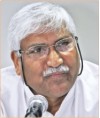 |
We have achieved some laudable success in reducing population growth rate. The people who are in the reproductive age are far more conscious now than the system was 20 years ago. So to keep up the success we need continuous investment in the institutions and in the quality of workers.
We usually miss the governance issue in our population related discussions. But this is central to the decision making process. It accommodates the policies considering how people will take it depending on socio-economic condition, political history and nature of political decision making.
The next thing is urban management. De-urbanisation will not take place so easily because our urbanisation has a different character which is more like rural urban continuum .To manage urban migration we have to invest more in rural areas. The government has to ensure basic facilities in those areas. Another point for the rural people climate change has severe consequences. For example the Sidr and Aila affected people are yet to recover a normal livelihood. It pushes people several years back in the history of development. These disasters undermine the capacity of the poor. So we have to take up the climate change issue seriously in our population management and poverty reduction planning.
Professor Omar Rahman
Acting Vice-Chancellor, Independent University of Bangladesh
 |
We have achieved laudable success in controlling our population otherwise we would have faced the fate of Pakistan which is going to touch its maximum population. Rather than hanging around numbers we should look into the issue of demographic composition. Our teenage fertility rate is very high relative to our total fertility rate. We should seriously consider this issue.
Aged marriage is going up. Huge investment in education should be given the credit for this. Among all the efforts, education has resulted in most fruitful ways. So we should continue the investment in education.
Regional inequality is another important point to address. We find very high fertility rate and low rate of education in Sylhet and Chittagong. These prove the common wisdom wrong that money is the panacea to all problems. We have to enhance our population control effort in these areas to bring down the overall rate further.
I do not find any problem in urbanization. By 2050, 50 % of our country will be urbanised. Urban growth has the potentiality to generate rapid economic growth. So we should look rather into the issues of planned urban management rather than deurbanisation .
Professor Barkat -e- Khuda
Department of Economics, University of Dhaka
 |
The family planning programme itself has been weakened due to lack of political will and commitment. There has been no discussion on population in the parliament for the last 40 years. If the top policy makers of the country say that population is an asset then what happens at the level of ministers or the secretaries or the DGs?
In the education sector considerable achievement has been made which has been a boon to the economic growth and population control. So we should give top most priority to education.
The next thing is economic arrangement for the growing population. Our planning commission sets a target of 7% GDP growth. If we want to be a middle income country by 2021, this growth rate is not enough. Our investment rate had stagnated around 25% for the last two decades. Savings rate has increased but not the investment rate. We are suffering a soaring inflation. Due to the ongoing troubles in the Middle East and North Africa we have to reassess the prospects of remittance. Agriculture, which is a low productive sector, continues to employ half of the labour force. Service sector is also a low productive sector. Unless we can increase high productive manufacturing sector our GDP and wages will not grow. So we have to seriously focus on the economic arrangement to accommodate our growing populations so that we can ensure standard living for them.
Next is the food production issue. Despite the fact that food production has increased considerably we still continue to import food. About 45% of the population in 2006 was food insecure. We are also losing our agricultural land. So these should be our serious concern.
Another issue is urban migration. We are getting low-skilled and semi-skilled workers from rural areas. It is forced or push migration not pull migration. We have to immediate steps to empower them with adequate training and provide them better living facilities.
Professor Nashid Kamal
Department of Public Health, North South University
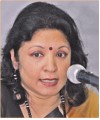 |
I want to focus on the urban slums. Research findings show that they are most neglected. The Government has very little arrangement to provide them adequate family planning facilities. China has made significant development in this sector. We can follow the good examples of China.
Another important point is the development of the slum inhabitants. They are not supposed to live in the slum. Government should empower them with adequate training so that they can return back to find a better employment out of the city.
Promit Ananyo Chakroborty
UNFPA faciliated National Youth Forum (NYF)
 |
The rich people do not make their daughter to have married early. But I have seen many business tycoons who have four or five daughters but still want a son thinking that the son will look after him and his property on his old age. Such practices are still haunting our minds and cause us to suffer a lot. Without empowering women we cannot get rid of this menace. Women have to be well educated so that they can raise their voice and take their decisions themselves, like whether she wants a child or not. Rural people are the worst victims of such taboos. We have to bridge the gap and reach every corner of the country.
Kazi Ali Reza
UNIC
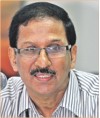 |
Our population mostly suffers from poverty. We have passed 11 years of our stipulated MDG time line of 15 years. Our achievement is very good in statistics. But the fact that when we got independence 80% of our population lived below poverty line and the number was 60 million. Now though we have achieved less percentage but the number of poor people remains same. This is staggering. Another haunting statistics is that we are losing our 1% agricultural land every year. This is alarming. Villages are expanding. The distance between villages is not that large as it was 30 years ago. People are using agricultural lands to accommodate growing population which will create severe pressure on our food security.
Farzana Yesmin
UNFPA faciliated National Youth Forum (NYF)
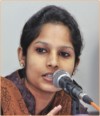 |
We do not have much knowledge about the adolescent health and reproductive health issues. I think we should create awareness among the adolescents especially.
Ella de Voogd
First Secretary, Royal Dutch Embassy
 |
Inequality between man and woman in the household worries me a lot. Woman has no right to decide whether she should go to the doctor or not.
Government should give top priority to the women empowerment issue.
Dr. Nasrin Akhter
Plan Bangladesh
 |
As I have experience of working in the urban slums, I find that our stock of contraceptive finishes by the mid of the month and rest of the month we have to wait for the next round of supply. So there remains a huge gap in government's contraceptive supply management. We have seen that our total fertility rate has declined but the truth is that it does not occur among the projected unreached people. For example, in Sitakunda , the family of the Tripura community generally consists of 8-10 members . They are not aware of any health and family planning information. In the north I find that reproductive healthcare mainly cover married adolescents and ignore other adolescent groups. It is very important to raise awareness among the adolescent about the reproductive health and family planning. So our school curriculum should include such information.
Dr. Gias Uddin
Deputy Director, DGFP
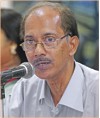 |
Family planning department is the leading department in the sector of population control. But we need joint effort from all other stakeholders. Family planning department previously suffered due to lack of manpower and weak infrastructure. But now we have enough manpower and other facilities. We have taken the adolescent programme seriously. We are trying to educate the youth and create a convenient environment to cooperate with us. We have taken some action plan to provide uninterrupted supply of reproductive health and family planning commodities. Early marriage is a serious concern for our department. Birth registration is a very important factor to confirm the age. So it should be popularized . Finally, a proactive media is a must to disseminate such information to the people.
Dr. Shamsul Alam
Member, General Economic Division, Planning Commission
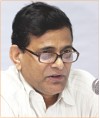 |
The population is beyond the capacity of our land. We are losing 1% of our cultivable land every year. This is a very serious concern.
We are now enjoying a demographic dividend as we have 63% of our population between 15 to 43 who are very much active. The situation will not stay long. We should utilise this dividend for our rapid development.
We need a separate ministry for population which has to now share with health ministry. We need a lot of worker who would go door to door to advise and motivate marginal people. So we need more budget and allotment in this sector. We have 84 social safety net programmes in operation, being implemented by 14 ministries. We would urge that these safety net programmes should be linked to population programme. We should make primary education compulsory in the rural areas. During the last 40 years primary education has achieved remarkable success in reducing 35 % of our poverty.
The last point is that urban migration rate is very high which cause hazards in urban slums further. So we have to be more attentive to the slums.
AKM Zafar Ullah Khan
Policy Advisor, Population Council
 |
I would focus on the minimum age of marriage. Now it is 18 which is also the last limit of childhood. We should raise the age barrier. Our members of parliament are also convinced that there should be some amendment in that law. The honourable Speaker has said that it should be 20. However, the more important thing is that how we would implement the barrier. We have suggested one option to register the marriage. The registration process should consider the age certificate provided by the school authority. Compulsory female education is another option. No girl should be allowed to be married before completing class 10.
Habibur Rahman
Deputy Secretary, Ministry of Health and Family Welfare
 |
Now we are following the policy of 2004.We have to update our national population policy. Another point is that though we have more manpower compared to 20 years ago but we need more. The good thing is that we are now recruiting man power. And the last point we need publicity, we need to create awareness so we need the media.
Arthur Erken
UNFPA Representative
In summing up the discussion, I see six challenges to be considered seriously:
First is 'managing population'. We need to revitalise the national family planning programme. Not a “one-size-fits-all programme, but a programme targeting the underperforming and hard-to-reach areas, that focuses on the existing unmet demand for family planning, that addresses the sexual and reproductive health needs of young people, and a programme that promotes the use of long acting and permanent methods of family planning.
Second is massive investment in agriculture so that we can produce enough food for the growing population.
Third is urban planning. Urbanisation is needed for economic growth. But it has to be well planned. In Bangladesh, cities grow horizontally, 'eating' up a lot of agricultural land. We cannot afford that. We have to find ways of accommodating more population on less land. Another thing we have to do is invest more in the health and well-being of urban slum dwellers.
Fourth is massive investment in education. I would like to focus specially on the quality of secondary and tertiary education, because ultimately, Bangladesh needs skilled manpower.
Fifth is the empowerment of girls and women. We cannot go forward keeping behind 50% of the population.
The last one is developing a congenial business environment. Bangladesh needs to attract more foreign direct investments (FDI). To attract FDI, we need a good business climate.
Whether population would be an asset or a burden depends on how we whether we make the right choices today and invest in people, particularly our young people.
Dr. Noor Mohammad
Assistant Representative, UNFPA
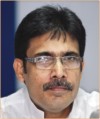 |
Thank you very much all the speakers who spoke in this policy dialogue. Today, with all important suggestions, it came out very clearly that we need to focus two important segments of population to overcome the challenges. And they are: women and young people. We all know half of our total population is women. If we left them idle, do not bring them into the development arena, we cannot prosper. Thus, we need to empower them economically and politically, consult them in taking decisions. The other important segment of population is young people; they are one-third of the total population. As we heard from the key-note presentation that a huge working-age population we have now in Bangladesh, we need to develop this youthful population into skilled person-power, otherwise we will miss the opportunity. They can give the dividend. The window of opportunity is knocking at our door, we should take the opportunity and for that we have to start undertaking comprehensive policies now and act immediately.

